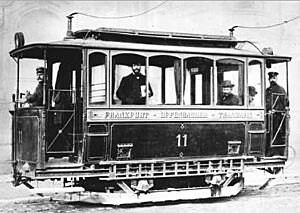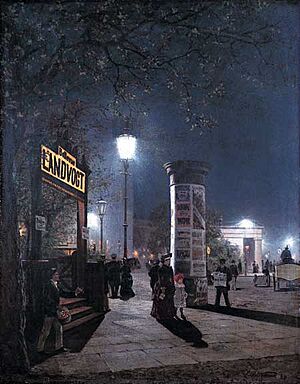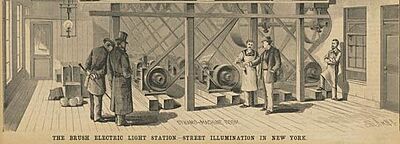History of electric power transmission facts for kids
Electric power transmission is all about moving electricity from where it's made to where people use it. This amazing process started in the late 1800s. It includes sending huge amounts of power over long distances, which is called transmission. It also covers delivering electricity to homes and businesses, known as distribution. At first, these two words were often used to mean the same thing.
Contents
How We Used to Move Power Around
Before electricity, people found other ways to move power over long distances. Some systems used moving cables, like for cable cars. Others used pressurized air or water. For example, London had a system that used high-pressure water pipes. It delivered power to factory motors.
These older systems were later replaced by electricity. Electric power was cheaper and could be used for many more things. But city planners already knew how useful it was to have a central power system.
In the early days, sending electric power far away had two main problems. First, different devices needed different amounts of electricity, called voltage. This meant you needed separate power lines for street lights, factory motors, or home lights. Second, power generators had to be very close to where the electricity was used, usually less than a mile.
Scientists knew that if they could increase the voltage, they could send electricity much farther. So, solving both problems meant finding a way to change voltages easily from one main power line.
Special Power Systems

Most early electricity was direct current (DC). It was hard to change its voltage up or down. This made it difficult to send DC power over long distances. It also meant you couldn't easily share one power line for different types of electric devices.
Companies often had to run separate power lines for different uses. For example, arc lamps needed very high voltage, sometimes 10,000 volts. Home lights used 110 volts. Streetcars needed around 500 volts. Factories used other voltages. Because of this, it seemed like electricity would be made by many small generators. These generators would be placed close to where the power was needed.
Early Outdoor Lighting with High Voltage
Early researchers were very interested in using high voltage. They knew it could help send power over long distances. A basic electricity rule says that if you double the voltage, you can cut the current in half. This sends the same amount of power. Also, power lost as heat in a wire depends on the square of the current. So, by doubling the voltage, the same wire could send power four times farther!
At the Paris World's Fair in 1878, electric arc lights were used. These lights needed high voltage. Soon, people found that these arc lamps could work on a circuit 14 kilometers (about 9 miles) long. Within ten years, many cities had lighting systems. A central power plant would send electricity to many customers using power lines. These electric systems competed with the gas lighting that was common at the time.
The idea of building a central plant and a network to deliver energy was not new. It was like the successful gaslight business. The only difference was that electricity was delivered, not gas. And the "pipes" for electricity were more flexible.
In 1879, the California Electric Company in San Francisco started selling electricity. They used two direct current generators to power arc lamps for many customers. This was the first time a company sold electricity from a central plant to many users. By the end of 1881, many cities like New York and Boston had arc lamp systems. These systems provided public lighting well into the 1900s.
Direct Current Lighting for Homes
Early arc lights were very bright. But their high voltage also made them dangerous for indoor use. In 1878, Thomas Edison saw a chance to bring electric lighting directly into homes and businesses. This was something arc lighting systems couldn't do.
After inventing a successful incandescent light bulb in 1879, Edison built the first large electric power company. It was in lower Manhattan, New York City. It eventually served one square mile. The power came from six huge generators at the Pearl Street Station. When it opened in September 1882, it had 85 customers and 400 light bulbs. Each generator made enough power for 1200 lights. The electricity was sent at 110 volts through underground cables. Building this system was very expensive, especially laying the 100,000 feet (30,000 meters) of cables. Edison also had a special three-wire system. It could provide either 110 volts or 220 volts for some motors.
Transformers and Alternating Current

When George Westinghouse became interested in electricity, he quickly realized something important. Edison's low-voltage direct current was not efficient enough for large power systems. Westinghouse understood that long-distance power needed high voltage. He also knew that only alternating current (AC) had cheap ways to change voltage.
Transformers became key to AC winning over DC for power transmission. In 1876, Pavel Yablochkov used induction coils to step up voltage for his arc lamps. Later, in 1881, Lucien Gaulard and John Dixon Gibbs made a more efficient device. They called it a "secondary generator," which was an early step-down transformer.
The first long-distance AC power line was built in Italy for an exhibition in 1884. It sent power 34 kilometers (21 miles). This system showed that AC power could be sent over long distances.
Between 1884 and 1885, Hungarian engineers Károly Zipernowsky, Ottó Bláthy, and Miksa Déri created the efficient "Z.B.D." transformers. They also invented the modern electric distribution system. They found that older devices couldn't control voltage well. Their new design had a "closed core" or "shell core." In these designs, the magnetic power stays mostly inside the iron core. This made it possible to provide electricity for lighting in homes and businesses. Ottó Bláthy also figured out the main formula for transformers. These inventors were also the first to use the word "transformer."
The idea of using inexpensive transformers to step up and step down voltage was first put into practice in 1886 in Great Barrington, Massachusetts. This was done by Westinghouse, William Stanley, Jr., and Franklin Leonard Pope. In 1888, Westinghouse also got the rights to Nikola Tesla's induction motor. This motor would become a useful AC motor. The modern three-phase AC system was developed in Europe starting in 1889.
The Victory of AC Power
The International Electro-Technical Exhibition of 1891 in Germany was very important. It showed the first long-distance transmission of powerful, three-phase electric current. The electricity was generated 175 kilometers (109 miles) away and successfully powered motors and lights at the fair. This success proved that three-phase AC was the most economical way to send electrical energy.
Three-phase generators and motors were simple, efficient, and cheap to make. They also needed little maintenance. This made the older, complex DC generators disappear. The main reason AC won the "war of the currents" was the availability of cheap transformers. These transformers meant that all customers, no matter their voltage needs, could get power easily. This "universal system" is now seen as one of the most important inventions for using electricity.
By connecting many power plants over a large area, the cost of making electricity went down. The most efficient plants could be used to supply power throughout the day. Reliability improved, and less money was needed for backup power. This is because backup power could be shared among many more customers. Also, cheap energy sources like hydroelectric power could be used.
From Willamette Falls to Niagara Falls
In 1889, the first long-distance DC electricity transmission in the United States happened in Oregon City, Oregon. However, a flood destroyed the power station in 1890. This led to the first long-distance AC electricity transmission in the world. The Willamette Falls Electric company installed experimental AC generators from Westinghouse.
Around the same time, the Niagara Falls Power Company (NFPC) wanted to use Niagara Falls to make electricity. They formed a group of experts to study how to do this. They even thought about using compressed air to send power, but they preferred electricity.
By 1893, the Niagara Falls Power Company chose Westinghouse to build the generators. General Electric got contracts for power lines and transformers. Work began in 1893. The plan was to generate 5,000 horsepower (3,700 kW) and send it as alternating current. They chose a frequency of 25 Hz to reduce power loss during transmission. (This was changed to 60 Hz in the 1950s.)
Westinghouse also had to create a system to provide all the needed power types. This included single-phase and polyphase AC, and DC for streetcars and factory motors. The first customer for the power from Niagara Falls in 1895 was a company that needed a lot of cheap electricity to make aluminum. On November 16, 1896, electricity from Niagara Falls began powering streetcars in Buffalo.
In 1907, a new invention called the disc insulator allowed much higher voltages to be used for power lines. This was a big step forward.
Early 1900s Power Growth
The voltages used for sending electric power kept increasing throughout the 1900s. The first "high voltage" AC power station, rated at 4 megawatts and 10 kilovolts, started in London in 1889. The first electric power line in North America operated at 4000 volts. It went online on June 3, 1889, connecting Oregon City and Portland, Oregon, about 13 miles (21 km) apart.
By 1914, there were 55 transmission systems working at more than 70,000 volts. The highest voltage used then was 150 kilovolts. The first three-phase AC power transmission at 110 kilovolts happened in 1907 in Michigan. Voltages of 100 kV and more became common about five years later. For example, the first 110 kV line in Europe was built in Germany in 1912.
In the early 1920s, lines were built or upgraded to 220 kilovolts in California. These lines brought power from hydroelectric plants to cities like San Francisco and Los Angeles. By 1929, Germany had its first 220 kV line, connecting several cities. This line was one of the world's largest power systems at the time.
The world's first 380 kV power line was built in Sweden in 1952. In 1965, the first super-high-voltage transmission at 735 kV happened in Canada. In 1982, the first transmission at 1200 kV was in the Soviet Union.
The fast growth of industries in the 1900s made electric power lines and grids very important. Connecting local power plants and small networks became even more important during World War I. Governments built large power plants for factories. Later, these plants were connected to supply power to cities through long-distance lines.
Engineers like Samuel Insull in the United States and Sebastian Ziani de Ferranti in the United Kingdom helped overcome many challenges. They made long-distance electric power transmission possible. For example, in London, the cost of electricity dropped to one-third in ten years because of these power networks.
In 1926, electric networks in the United Kingdom began to be connected into the National Grid. It first operated at 132 kV.
Power Electronics
Power electronics is about using modern electronic parts to control and change electric power. This field started with the invention of the mercury arc rectifier in 1902. This device changed alternating current (AC) into direct current (DC). From the 1920s, scientists worked on using similar devices for power transmission. Uno Lamm developed a mercury valve that was good for high-voltage direct current power transmission.
|




